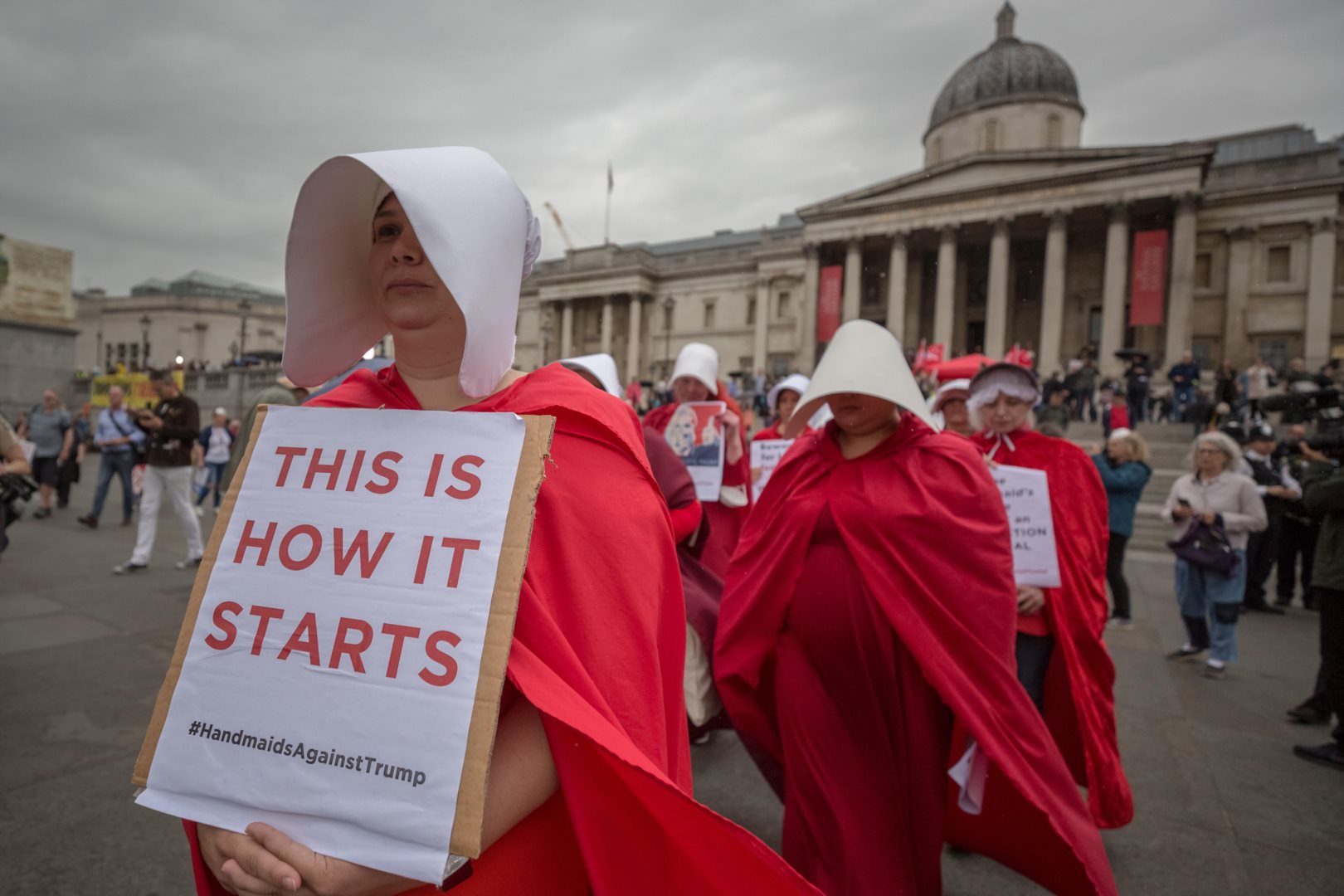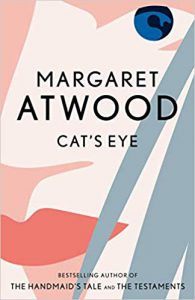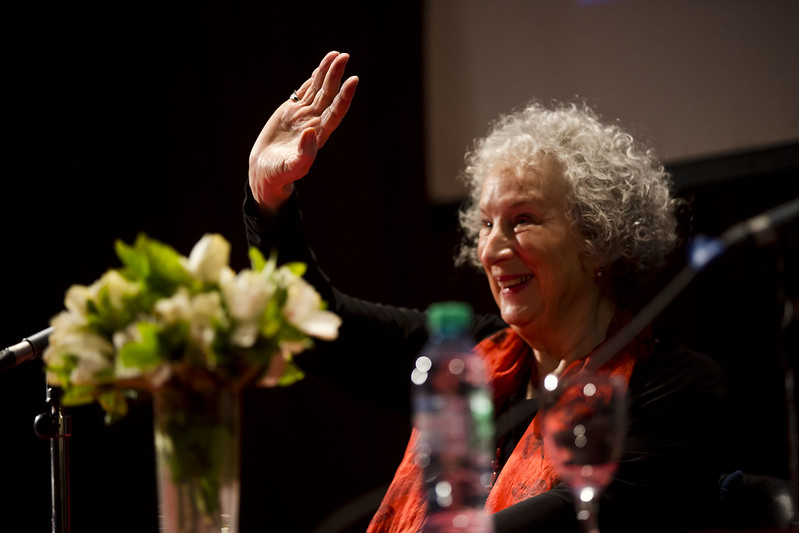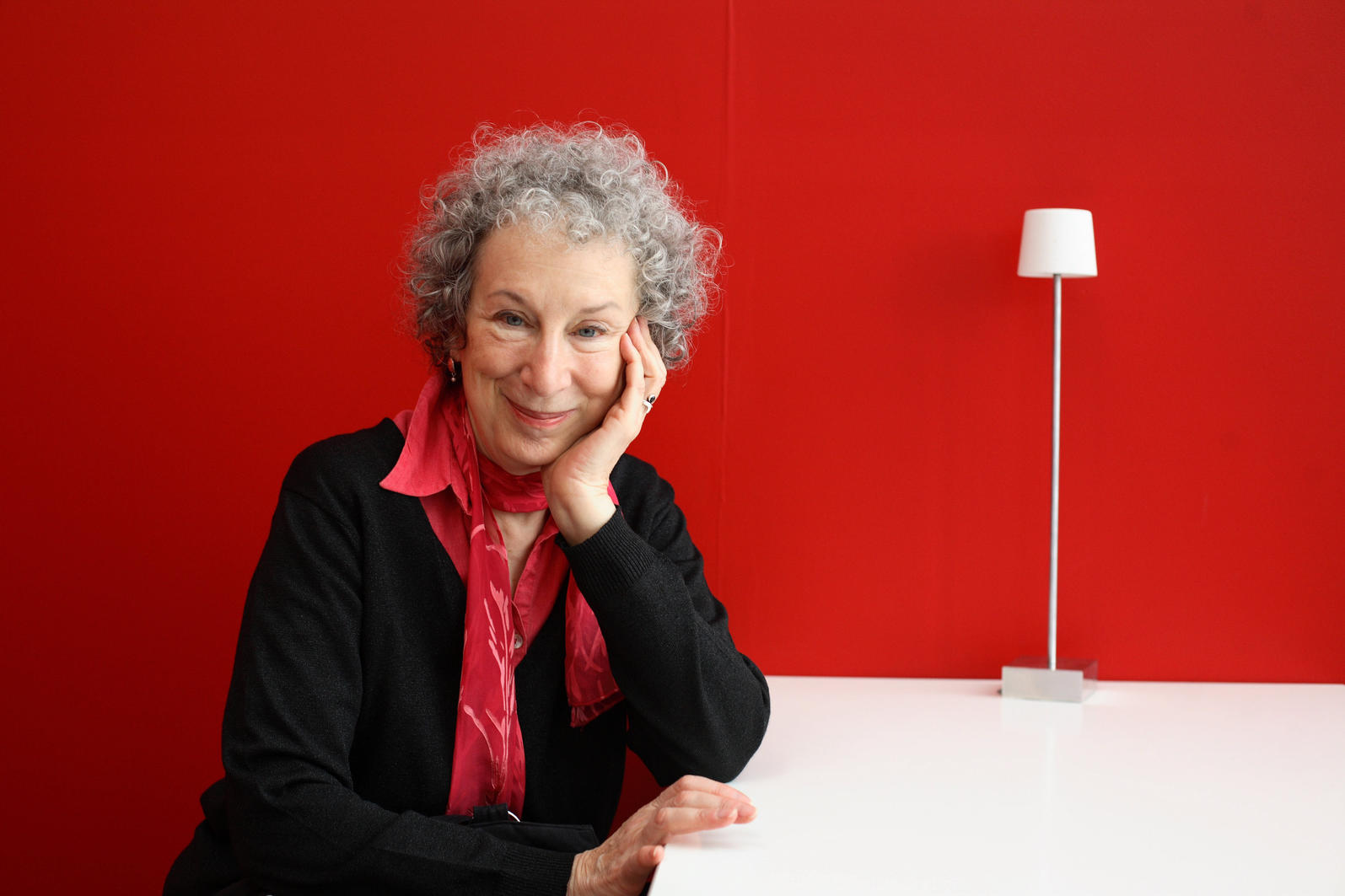Books
Margaret Atwood Wrote a Great Novel. Unfortunately, Her Fans Turned It Into a Cult
Atwood’s innovation is to give this dystopian nightmare the distinctly female framing of domestic and sexual enslavement—as experienced by “Offred,” a “Handmaid” assigned to a man named Fred and his wife for surrogate motherhood via monthly copulation.

Among the notable cultural events of the last decade, one must count the emergence of the Handmaid’s Tale franchise: the hit television series loosely based on the 1985 dystopian novel by Canadian writer Margaret Atwood, the novel’s return to bestsellerdom as a trade paperback, and The Testaments, Atwood’s 2019 sequel, which won the Booker Prize and has topped the New York Times best-seller list, where it is currently in its 16th week and in fifth place. It is a phenomenon that has made Atwood, who turned 80 last November, not only a celebrity but a cultural icon: “Queen Margaret,” as The Atlantic recently dubbed her. She was the subject of a recent 7,000-word interview in New York magazine, as well as one of Glamour magazine’s “Women of the Year” for 2019.
There is a certain irony in Atwood’s cultural queenship. The significance of The Handmaid’s Tale is not primarily artistic but political: Set in a speculative world where the United States has been taken over by an oppressive, hideously misogynistic regime, it is seen as a warning that women’s rights are in perpetual peril—and, more recently, as a terrifyingly “prescient” commentary on America in the age of Donald Trump. “Sentences that she wrote in the 1980s bloom, chillingly, in 2019,” feminist pundit Rebecca Traister declared while introducing Atwood at a belated birthday celebration at the New York Public Library in December.

Atwood herself has backed such a reading. And yet she has long shown an ambivalence about being cast as a “feminist writer”: One senses that her heroine in the 1988 novel Cat’s Eye, an artist, speaks for the author when she responds to a question about being called a “feminist painter” with, “I hate party lines. I hate ghettos.” Atwood has still eschewed the label in some recent interviews. Even at the feminism-heavy New York event, she voiced misgivings about feminist inclinations to deny or condone female wrongdoing. (Recalling a reader who professed to identify with the sociopathic Zenia from Atwood’s 1993 novel The Robber Bride “because women are tired of being good all the time,” Atwood commented tartly, “I think you have to be careful about that.”)
Atwood’s relationship to feminism has been further strained by her support for the presumption of innocence for men accused of sexual abuse, and specifically for Canadian novelist and former University of British Columbia professor Stephen Galloway—a stance that made her a “bad feminist” in her own sarcastic words and a “rape apologist” to detractors in places like The Mary Sue, the Pravda of online pop-culture feminism.
Those issues never came up at the New York event, where the mostly female audience of 200 or so greeted Atwood like a pop star. So far, it seems, the Handmaid’s Tale cult has easily survived Atwood’s offenses against wokeness, just as it has survived accusations of “white feminism” and, horror of horrors, “colorblindness”: It has become a symbol of the “Resistance,” the book and TV equivalent of the Women’s March.
But that’s a mixed blessing, because this cult does Atwood a disservice. It has resulted in elevating some of her weaker work (namely The Testaments, though arguably even The Handmaid’s Tale is not among Atwood’s first-rank novels) while overshadowing far superior novels and poetry written over the course of a career that spans nearly six decades. And, especially via the TV adaptation—on which Atwood herself served as a consultant—it has also flattened her complex vision into a simplistic screed.
While The Handmaid’s Tale’s ultra-patriarchal world is now interpreted as a metaphor for the Trump-era “war on women,” it was first conceived as a commentary on the Reagan era and the rise of the Christian Right: In Atwood’s dystopian future, the United States has been replaced by the Republic of Gilead, a fundamentalist Biblical theocracy where women are relegated to forced domesticity or breeder slavery.
In a 2012 essay on The Handmaid’s Tale, Atwood wrote that when it first came out, the most common reaction from American readers was, “How long have we got?” But perhaps this mainly tells us something about Atwood’s American readership—or at least those readers whose reactions she heard. The literary doyenne Mary McCarthy, who reviewed the novel for the then-still-unwoke New York Times, emphatically disagreed, writing that its “lurid pages” made her feel “no shiver of recognition,” and that she simply couldn’t see the religious Right’s crusades against abortion, gays and offensive library books leading to a dictatorship of “super-biblical puritanism.” Noted feminist author Barbara Ehrenreich called the book “absorbing,” but also described it as “feminist paranoia,” and found its dystopian world unimpressive, writing that “Gilead seems at times to be only a coloring book version of Oceania,” the totalitarian superstate of Nineteen Eighty-Four.
Despite this unflattering comparison to the George Orwell classic, The Handmaid’s Tale has undeniable power as a depiction of life under totalitarianism: the bleakness of day-to-day living, the dangerous pleasure of small private rebellions, the pervasive paranoia, the knowledge that one is in the absolute power of a malignant and omnipresent them. (When I first read the novel in 1986, it had been only six years since I’d left the Soviet Union as a teenager, and the shiver of that recognition was definitely present for me—even if the Brezhnev-era totalitarianism I knew was of a watered-down variety.)
Atwood’s innovation is to give this dystopian nightmare the distinctly female framing of domestic and sexual enslavement—as experienced by “Offred,” a “Handmaid” assigned to a man named Fred and his wife for surrogate motherhood via monthly copulation. The framing is highly effective, especially since Atwood is a master of mood and atmosphere: Something as simple as Offred sneaking out of her room for an unsanctioned late-night visit to the kitchen can be imbued with both excitement and terror. And there are other compelling details, from Gilead’s creepy ritualized language—especially the parting salutation, “Under His Eye,” in which God merges with Big Brother—to the public hanging, or “Salvaging,” where spectators must participate by laying their hands on the long rope that ends in the noose.
But where The Handmaid’s Tale fails is in creating a plausible “it can happen here” scenario of takeover by an American Taliban. Atwood’s set-up involves a demographic collapse (caused by epidemics and environmental disasters that lead to rampant infertility and birth defects) and a coup engineered by a group of religious zealots, the “Sons of Jacob.” After the President and Congress are slaughtered in a terror attack blamed on “Islamic fanatics,” the U.S. military imposes a state of emergency and suspends the Constitution, and the Sons of Jacob, who have presumably infiltrated the army, take over. Women are abruptly stripped of civil rights, protests are ruthlessly crushed, and soon enough the dictatorship solidifies into a fundamentalist regime that bans all secular culture, outlaws all faiths other than its own, herds black people into “homelands,” deports Jews, and gets busy hanging gays and heretics. Meanwhile, “sinful” fertile women—i.e., single and divorced mothers—are rounded up and forced into service as concubines for high-status men with barren wives, while their children are placed with elite childless couples.
What are the odds? Nonexistent.
Never mind that the U.S. government has a “designated survivor” plan to ensure there will always be a legitimate acting President; never mind the 50 state governments, each with a National Guard. An even bigger issue is that Gilead would have no base of popular support. Even the most traditionalist of evangelical Christians would regard its religion, with its sanctioned polygyny, missing Jesus, and strategically edited Bible verses, as an odious, heretical cult—a fact Atwood seems to recognize when she mentions anti-Gilead Baptist rebels. Meanwhile, virtually all Americans would have to be forced into a way of life profoundly alien to their culture and history. One of Atwood’s models for Gilead was Iran’s 1979 Islamic revolution; but in Iran, women’s pre-revolutionary emancipation had been limited to the secularized urban elites, and such repressive norms as female veiling and sex segregation in public spaces were familiar to most of the population.

Ironically, in her 2012 essay, Atwood herself mentions that totalitarian regimes always have some cultural continuity with the societies they seek to transform; but she imagines that Gilead has such roots in the patriarchal theocracy of “17th Century Puritan New England.” Yet Puritan New England was not nearly as misogynistic as Atwood imagines: indeed, for its time, it was remarkably female-friendly, prohibiting “bodily correction” of wives and promoting literacy for girls as well as boys. By contrast, women in Gilead (except the female enforcers known as “Aunts”) are strictly forbidden to read and write.
Gilead’s impossibility may be the reason its world is, as Ehrenreich put it, “thinly textured.” Atwood’s attempt to have the regime’s official language mix Biblical ultra-traditionalism with 20th century slang—such as “Particicution” to describe execution by mob, a term that the epilogue reveals was coined by a commander with a marketing background and apparently inspired by “Jazzercise”—adds to dark comedy but subtracts from believability. A scene in which Offred in her burka-like garb is gawked at by Japanese tourists and finds the women obscenely underdressed is a heavy-handed “East-West” flip that rings equally false (tourists visiting a fanatical theocracy in the midst of a war?). And on occasion, Atwood seems to forget about the reading prohibition: One moment, the regime is so hell-bent on keeping letters from female eyes that even store signs are pictures-only; the next, there’s a banner announcing a “Women’s Prayvaganza,” and the wife of Offred’s commander casually mentions having “read [her] file” with no frisson of the forbidden. (Maybe one reason for these slip-ups is that the reading ban itself makes no sense and has no realistic precedent: Female educational attainment in Iran actually rose dramatically under the Islamic Republic despite other setbacks to women’s rights, and even the Taliban’s opposition extends only to “un-Islamic” materials.)
The Hulu television series, despite its excellent cast—particularly Elizabeth Moss as Offred/June Osborne, Yvonne Strahovski as the Commander’s wife Serena Joy, and Ann Dowd as the formidable Aunt Lydia—compounds the plausibility issues. The attempts to flesh out Gilead’s history make things worse, not better: The Sons of Jacob are ludicrously inept plotters, pre-Gilead America looks far too normal for a society reeling from demographic crisis, and we’re expected to believe that the whole world pretty much chugs along as usual when its largest economy (and a nuclear superpower) goes full Taliban.
What’s more, even the first season, whose storyline was loosely book-based—and which reaped many accolades and eight Emmy awards—frequently traded Atwood’s subtlety for soapy melodrama and grand guignol.
The novel’s Commander was a nuanced character toward whom Offred felt complicated emotions; the show’s version became a loathsome, lecherous bully. Serena Joy got an interesting backstory as a pro-traditionalist author/activist (rather than the novel’s ex-televangelist) but also became an unhinged uberbitch whose treatment of June lurched from affection to violent abuse. Fellow Handmaid “Ofglen,” a member of the rebel underground, took on a lurid storyline involving lesbian romance and clitoridectomy. Gilead’s brutality turned to random sadism: Early on, a future Handmaid at the women’s indoctrination center, Janine, had an eye removed for cursing at Aunt Lydia. (Meanwhile, June’s escape attempt and assault on another Aunt was punished with a painful but non-mutilating whipping on the feet.) Since the show also has to have its girl-power moments, these horrific cruelties coexist with incongruous scenes of sisterhood and defiance by the Handmaids.
The problems were magnified in the second season, when the showrunners left the book behind (and began to tangibly pander to the Trump-era “Resistance” with ripped-from-the-headlines topics such as assaults on the press, brutal border agents, and persecution of Muslims). Potentially interesting storylines—e.g., Serena and June teaming up to secretly take over some of the Commander’s official role after he’s hurt in a bombing—went nowhere. Handmaids were subjected to grotesque cruelties like mock executions, with no regard for the possibility of pregnancy and miscarriage. Janine and Ofglen/Emily were shipped to a Gileadean gulag where inmates have a short life cleaning up toxic waste, only to be promptly saved by a far-fetched plot device; another elaborate twist was blatantly contrived so that June could give birth on her own. Serena careened ever more wildly from psychotic monstrosity (punishing a very pregnant June by instigating and aiding her brutal rape by Fred, ostensibly with the intent of stimulating labor) to sisterly self-sacrifice.
In the third season, things went so off the rails that even some sympathetic reviewers grumbled. The sadism meter keeps going up (Handmaids with mouths stapled shut!). June becomes a badass feminist superheroine whose absurdly far-fetched plan to smuggle a party of Gilead’s stolen children across the border to Canada somehow works. She barely even pretends to be submissive anymore, making cheeky remarks to Aunt Lydia (whom we’ve seen cattle-prod Handmaids for far less) and bossing her new master, Commander Lawrence, a closet dissenter helping with the child rescue. True, June’s recklessness gets a few innocents killed along the way, but at season’s end the show still treats her as grandly heroic, and even her earlier critics are wowed into submission. “You’re fucking fantastic!” exclaims an underground member initially skeptical of the rescue plan. “June…She did this. She did everything,” gushes an adult escapee in the season finale.
Amidst all this, the show has entirely abandoned a notably thought-provoking aspect of Atwood’s novel: the suggestion that censorious, authoritarian feminism—the kind exemplified by the anti-pornography activism of the 1980s—helped enable the forces that created Gilead by supporting the notion that freedom leaves women perpetually exposed to male abuse. (Aunt Lydia herself suggests that Gilead is, in its own way, the fulfilment of feminist ideas about female community and women’s protection.) It could have been an especially interesting point to explore today, given that this brand of feminism is now back with a vengeance, with its adherents trying to excommunicate Atwood herself for defending due process. But there is no trace of it in the series. Instead, we get June snarling at Commander Lawrence when he gets cold feet, tries to call off the rescue mission, and reminds her that she’s in his house: “Men. Fucking pathological. You’re not in charge, I am.” Feminist critics and twitterfolk loved it.
While the series’ latest two seasons more or less continue where Atwood’s novel left off, The Testaments offers a different sequel: The fall of Gilead, 15 years after the events of The Handmaid’s Tale, as told by three different women who played a key role in it. The principal narrator is none other than Aunt Lydia, reimagined here as a behind-the-scenes subversive—a woman who joined the Gilead regime because it was either that or death, who got to wield substantial but always limited power in exchange for her co-operation, but who had been plotting Gilead’s demise all along.
As always, Atwood’s writing has power. The passages describing the future Aunt Lydia’s harrowing captivity after the Sons of Jacob takeover, and her fateful choice to join her captors and gun down a group of other women in a stadium to demonstrate loyalty, are particularly compelling. The Testaments works well as a first-person account by someone who has done terrible deeds for the sake of survival and wants to explain herself to future generations. “Two roads diverged in a yellow wood, and I took the one most travelled by. It was littered with corpses, as such roads are. But as you will have noticed, my own corpse is not among them,” Aunt Lydia observes, with characteristic dry wit.
And yet, compared to The Handmaid’s Tale, the new book has major problems—some of them noted by mostly friendly commentators, such as Katha Pollitt and Sarah Jones in The Nation and Kristen Roupenian (of “Cat Person” fame) in The New Republic. For one, the new version of Aunt Lydia is a blatant retcon, i.e. ex-post-facto rewriting of previous canon. There is literally nothing in The Handmaid’s Tale to suggest that this woman, who encourages her wards at the Handmaid reeducation center to berate a gang rape victim for having “led them on,” is anything other than a zealous enforcer for Gilead—whether for true-believer or power-seeking reasons, or both. Both Pollitt and Jones suggest that Atwood’s attempt to redeem Aunt Lydia is a cop-out or “liberal wish fulfilment”: What do you know, the woman who looked like a zealous patriarchal collaborator helping oppress other women was actually an undercover feminist fighter all along!
And then there’s the plot, in which Aunt Lydia works to bring down Gilead by collecting kompromat on Commanders and smuggling the compromising material out with help from two plucky teenagers (who are the other narrators—more on that in a moment). The shocking contents get published, which leads to the fall of Gilead because…what? A brutal theocracy that hangs religious dissenters and openly forces fertile women into breeder slavery is hopelessly compromised when the world learns that members of its elite do Very Bad Things privately, like marrying and murdering nubile girls? No, apparently (as the postscript reveals), it’s because the revelations included the commanders’ secret machinations against each other, triggering discord, purges and eventually a putsch. But if that was the goal, why couldn’t Aunt Lydia have simply snitched on commanders to other commanders, without engineering a super-risky border escape? Not as romantic or action-packed?
Speaking of romantic narrative devices, those two teens involved in Aunt Lydia’s scheme turn out to be long-lost half-sisters, namely Offred’s daughters: the one taken by Gilead, and the one born in Gilead (fathered by the Commander’s chauffeur Nick) and spirited away to Canada. Notably, major elements of the girls’ storylines are taken from the TV show: the older daughter’s new name, “Agnes,” and the younger’s legendary status in Gilead as the abducted “Baby Nicole.”
If The Testaments dips into the Hulu adaptation of The Handmaid’s Tale for its canon, Hulu, in turn, has already optioned The Testaments—either for a future series after this one is done, or as source material for future Handmaid’s Tale seasons. How this new and improved Aunt Lydia can be squared with the Hulu version, who not only has a different backstory but makes the original novel’s Aunt Lydia look like Mother Teresa, remains to be seen. Then again, her character arc couldn’t be any more schizophrenic than Serena Joy’s.
It’s hard to disagree with Jones’s conclusion that The Testaments is essentially “fanservice,” offering the Handmaid’s Tale TV following the uplifting “resistance” story it craves. It’s also worth noting that the first book’s critique of radical feminism is absent from the sequel. At one point, the Atwood hate club on Twitter freaked out over a passage in which Aunt Lydia helps frame a man for attempted rape, and especially over her wry aside that “innocent men denying their guilt sound exactly like guilty men.” But there’s a catch: the “innocent” man is actually a child molester whose real crimes cannot be disclosed without wrecking his victims’ lives, and who richly deserves his awful fate. In this scenario, it seems, even a false rape accusation is a blow struck for sisterhood.
While most of the Atwood celebration in New York focused on The Handmaid’s Tale and The Testaments as supposed parables for our time, there were a few moments in a different vein. In her introduction at the New York event, Rebecca Traister acknowledged that although The Handmaid’s Tale was a “formative experience” for her as a child, she felt that another Atwood book, Cat’s Eye, was “in a way more traumatizing.” In the later conversation with Atwood, Traister remarked, “So much of your work is about brutality in a one-gender direction—men being brutal to women. But Cat’s Eye is about female brutality to other women. It’s not talked about much these days.”

Indeed, The Handmaid’s Tale was followed by not one but two novels that deal with woman’s inhumanity to woman: Cat’s Eye, a Booker Prize finalist, and The Robber Bride. Cat’s Eye, whose narrator Elaine looks back at her small-town childhood and especially at her complicated history with her school “friend” and tormentor Cordelia, may well be Atwood’s finest work. (In response to Traister’s observation, Atwood noted that when the book first came out, some were shocked that she could write “female people” acting so viciously; on the other hand, she said, “many women said to me that it doesn’t go far enough.”)
The story of Cat’s Eye is rich and multilayered, but the relationship between the two girls is at the heart of it. Elaine, naïve and something of a misfit—due to her parents’ travels, she spent little time around other children as a preschooler—is relentlessly bullied by a trio of girls, with Cordelia as their ringleader, under the supposedly benevolent guise of teaching her proper social graces and norms; her loyalty to her tormentors makes the abuse worse. Later, the dynamics shift in complicated ways; but even as a grown-up and a successful artist, Elaine is haunted by Cordelia long after the latter has vanished from her life.
The Robber Bride was another standout, as was Atwood’s next novel, Alias Grace, a fictionalized treatment of an actual 19th century case of a Canadian immigrant housemaid sentenced as an accomplice in the murders of her employer and his housekeeper. That novel, also shortlisted for the Booker Prize, deftly wed the psychological thriller to social realism. It is certainly a “feminist” novel in the sense that its themes include specific gender-based burdens faced by young women, from the press’s morbid fascination with Grace’s sexuality after her arrest to her roommate and friend’s death from a botched abortion. But the principal male character, a psychiatrist who interviews Grace in the hope of learning the truth about her, is treated with just as much sympathy and insight as the women.
And yet there’s a good chance that for the rest of her life, Atwood will be defined by the Handmaid franchise. And so “Queen Margaret” may become her creation’s captive, just as George R. R. Martin fell captive to Game of Thrones, and J.K. Rowling’s reputation will forever remain a prisoner of Hogwarts. Such are the perils of creating a cult, even if that’s never what Atwood intended.






